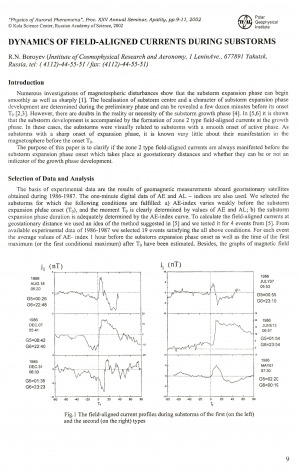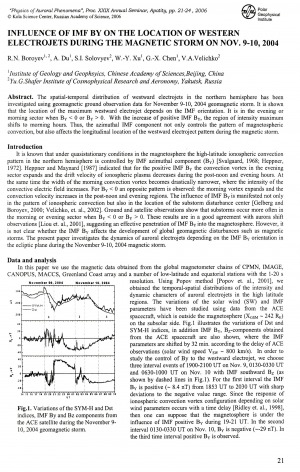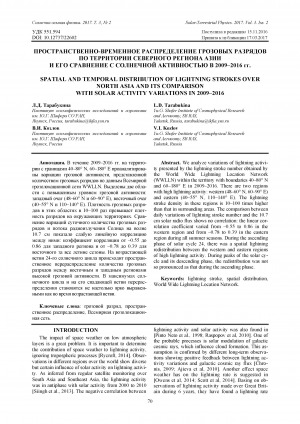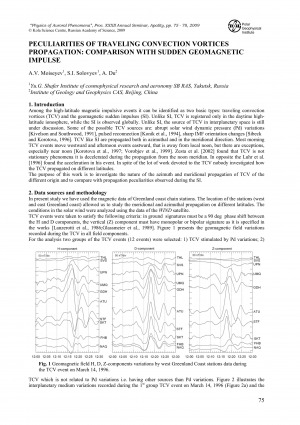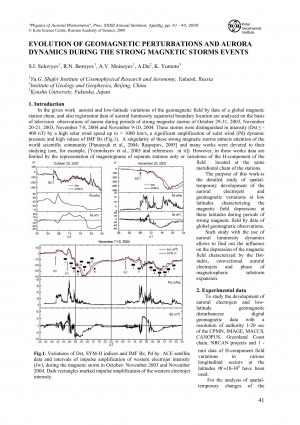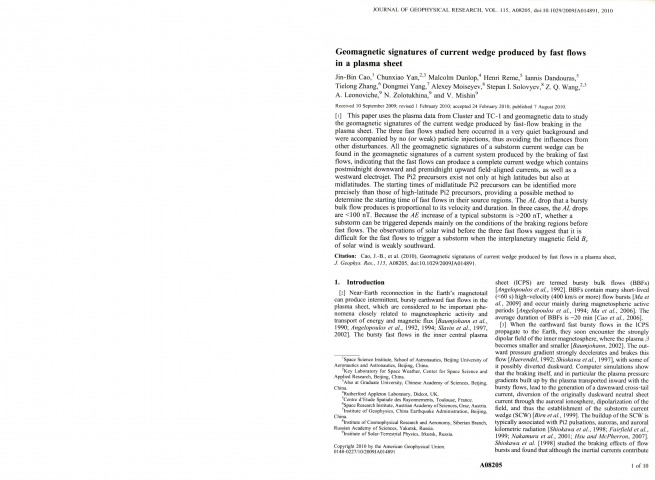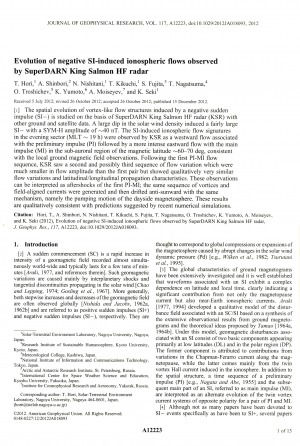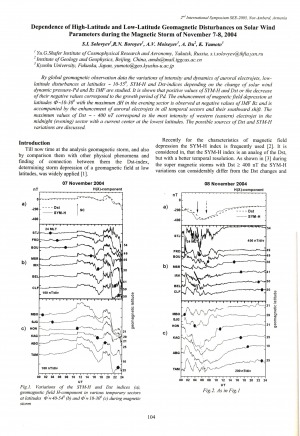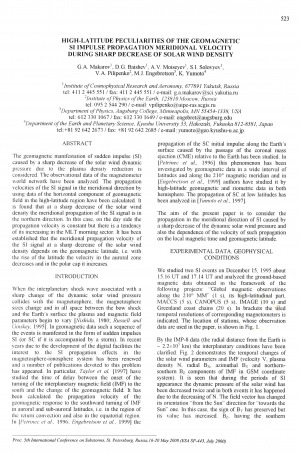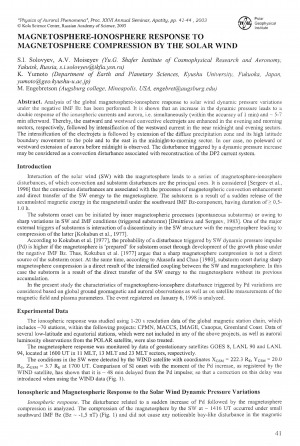Количество страниц: 3 с.
Boroyev, R. N. Dynamics of field-aligned currents during substorms / R. N. Boroyev // Physics of auroral phenomena : proceedings of the 25th annual seminar, Apatity, 26 February – 1 March 2002. – 2002. – P. 9-11.
Количество страниц: 4 с.
Influence of IMF by on the location of western electrojets during the magnetic storm on Nov. 9-10, 2004 / R. N. Boroev, A. Du, S. I. Solovyev, W.-Y. Xu, G.-X. Chen, V. A. Velichko // Physics of auroral phenomena : proceedings of the 29th annual seminar, Apatity, 27 February–3 March 2006. – 2007. – P. 21-24.
Количество страниц: 5 с.
We analyze variations of lightning activity presented by the lightning stroke number obtained by the World Wide Lightning Location Network (WWLLN) within the territory with boundaries 40-80° N and 60-180° E in 2009-2016. There are two regions with high lightning activity: western (48-60° N, 60-90° E) and eastern (40-55° N, 110-140° E). The lightning stroke density in these regions is 10-100 times higher than that in surrounding areas. The comparison between daily variations of lightning stroke number and the 10.7 cm solar radio flux shows no correlation: the linear correlation coefficient varied from -0.55 to 0.86 in the western region and from -0.78 to 0.39 in the eastern region during all summer seasons. During the ascending phase of solar cycle 24, there was a spatial lightning redistribution between the western and eastern regions of high lightning activity. During peaks of the solar cycle and its descending phase, the redistribution was not so pronounced as that during the ascending phase.
Tarabukina, L. D. Spatial and temporal distribution of lightning strokes over North Asia and its comparison with solar activity variations in 2009-2016 = Пространственно-временное распределение грозовых разрядов по территории северного региона Азии и его сравнение с солнечной активностью в 2009-2016 гг. / L. D. Tarabukina, V. I. Kozlov // Солнечно-земная физика = Solar-Terrestrial Physics. – 2017. – Т. 3, N 2 : 13-я российско-китайская конференция по космической погоде. – С. 70-74.
DOI: 10.12737/22602
Количество страниц: 4 с.
Moiseyev, A. V. Peculiarities of traveling convection vortices propagation: comparison with sudden geomagnetic impulse / A. V. Moiseyev, S. I. Solovyev, A. Du // Physics of auroral phenomena : proceedings of the 32nd annual seminar, Apatity, 3 – 6 March 2009. – 2010. – P. 75-78.
Количество страниц: 4 с.
Evolution of geomagnetic perturbations and aurora dynamics during the strong magnetic storms events / S. I. Solovyev, R. N. Boroev, A. V. Moiseyev, A. Du, K. Yumoto // Physics of auroral phenomena : proceedings of the 32nd annual seminar, Apatity, 3 – 6 March 2009. – 2010. – P. 41-44.
Количество страниц: 6 с.
Geomagnetic signatures of current wedge produced by fast flows in a plasma sheet / Jin-Bin Cao, Chunxiao Yan, Malcolm Dunlop, Henri Reme, Iannis Dandouras, Tielong Zhang, Dongmei Yang, Alexey Moiseyev, Stepan I. Solovyev, Z. Q. Wang, A. Leonoviche, N. Zolotukhina, and V. Mishin // Journal of Geophysical Research: Space Physics. – 1978. – 2010 (August), vol. 115, N 8. – P. A08205.
Количество страниц: 14 с.
Evolution of negative SI-induced ionospheric flows observed by SuperDARN King Salmon HF radar / T. Hori, A. Shinbori, N. Nishitani, T. Kikuchi, S. Fujita, T. Nagatsuma, O. Troshichev, K. Yumoto, A. Moiseyev, and K. Seki // Journal of Geophysical Research: Space Physics. – 1978. – 2012 (December), vol. 117, N 12. – P. A12223.
DOI: 10.1029/2012JA018093
Количество страниц: 4 с.
Dependence of High-Latitude and Low-Latitude Geomagnetic Disturbances on Solar Wind Parameters during the Magnetic Storm of November 7-8, 2004 / S. I. Solovyev, R. N. Boroyev, A. V. Moiseyev, A. Du, K. Yumoto // Solar Extreme Events Fundamental Science and Applied Aspects Nor-Amberd, Armenia 26-30 September 2005 : proceedings of the Second International Symposium / edited by A. Chilingarian and G. Karapetyan. − Erevan : Cosmic Ray Division, Alikhanyan Physics Institute, 2006. − P. 104-106.
Количество страниц: 4 с.
High-latitude peculiarities of the geomagnetic SI impulse propagation meridional velocity during sharp decrease of solar wind density / G. A. Makarov, D. G. Baishev, A. V. Moiseyev, S. I. Solovyev, V. A. Pilipenko, M. J. Engebretson, K. Yumoto // Proceedings of the Fifth International Conference on Substorms : 16-20 May 2000 Congress Centre of the Arctic and Antarctic Research Institute, St. Petersburg, Russia. − Noordwijk, Netherlands : European Space Agency, 2000. − P. 523-526.
Количество страниц: 4 с.
Magnetosphere-ionosphere response to magnetosphere compression by the solar wind / S. I. Solovyev, A. V. Moiseyev, K. Yumoto, M. Engebretson // Physics of auroral phenomena : proceedings of the 26th annual seminar, 25 - 28 February 2003. – 2003. – P. 41-44.
